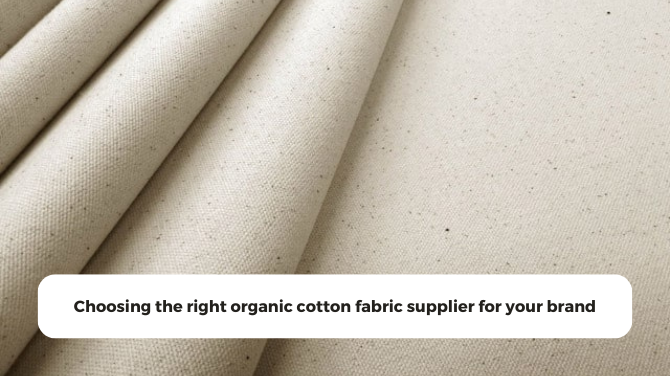Walk into any retail shop now and you’ll spot tags saying “organic cotton.” A few years back it was niche, today it’s almost standard. Buyers ask for it because customers are more aware. They want clothes that feel safe on skin and also less harmful on the planet.
Organic cotton is grown without chemicals or GM seeds. Cleaner fiber, softer hand feel, better for farmers. For brands, it’s not just a marketing line anymore, it’s survival. If you want to stay in tune with where fashion is going, organic cotton has to be in the mix.
But here’s the thing: it’s not only about the fiber. The supplier you choose can make or break your program.
Check out our digital swatches here
What makes a good organic cotton fabric supplier
We’ve seen a lot of mills call themselves “organic.” Reality? Few can back it up. What sourcing managers usually check before trusting someone:
- Certifications (GOTS, OCS, OEKO-TEX). No certificate, no proof.
- Consistent weaving. Organic yarns behave differently, need right handling.
- Finishing quality. Fabric should dye evenly, hold up after wash, not just “look organic.”
- Traceability. Buyers want to know the yarn origin and process trail.
- Flexibility. From a few meters for swatches to bulk, supplier should be able to support without delays.
That’s the baseline. Without these, you risk issues halfway through production.
The questions buyers keep asking us
When merchandisers get in touch, they don’t ask fancy questions. It’s straight and practical:
- Can you share swatches in different GSMs?
- Do you have both yarn dyed and solid dyed?
- How do you handle shrinkage control?
- What’s the MOQ for sampling?
- Can you show test reports or cert copies?
Simple questions, but behind them is real concern: will this fabric hold up in bulk, and can I trust it to be truly organic?
Where organic cotton works best
We’ve seen it used across categories. Some common ones:
- Shirts and blouses
- Casual dresses
- Kidswear (big one, since parents care about skin safety)
- Loungewear and innerwear
- Uniforms for schools or corporates
Basically anywhere cotton already works, organic cotton can slide in. The performance is familiar, but you’re also giving customers a cleaner story.
The tricky side of sourcing organic cotton
Let’s be real. Organic cotton isn’t always smooth. Supply is smaller than regular cotton, so sometimes lead times stretch. Prices are higher too, because farming and certification costs add up.
That’s why the supplier’s role matters. A good one will already have yarns booked, offer lower MOQs to test programs, and keep finishing tight so wastage stays low. Even if cost is slightly higher, efficiency makes up for it.
How we handle it at Dinesh Exports
We weave and finish in-house, so we’re not dependent on multiple vendors. For organic cotton, this is key. We can control shrinkage, color fastness, GSM — all under one roof.
What we put on the table:
- Certified yarns on request (GOTS, OCS).
- GSM choice from 60 to 500.
- Solid dyed, yarn dyed, or greige.
- Eco-friendly dyes and finishes.
- Swatch support and lab dips for approvals.
- Small runs possible before scale-up.
Whether it’s a startup running a 300-meter trial or a big brand doing 5 million meters, the process stays the same.
Quick checklist for merchandisers
Before locking a supplier, make sure you:
- Ask for the certification copy.
- Test swatches across GSMs.
- Check finishing, not just yarn.
- Confirm lead times early.
- Lock MOQs in writing.
This avoids surprises later.
Why it helps your brand story
End customers want more than fabric. They want to trust the story. Labels that say “organic cotton” stand for care and ethics. If the supply chain is clean, that story adds real value.
For buyers and merchandisers, it reduces risk and helps collections sell smoother. For the brand, it’s a trust signal.
Final word
Organic cotton fabrics are now part of the basics. They’re not just nice-to-have anymore. But the difference between a fabric that works and one that fails often comes down to the supplier.
At Dinesh Exports, we’ve built our organic cotton line to be consistent, certified, and traceable. From swatch to shipment, we support sourcing teams to get the right weave, GSM, and finish for their market.
If you’re looking for an organic cotton fabric supplier you can rely on, let’s talk.
📌 Global Organic Textile Standard (GOTS)
📹 The journey of organic cotton – YouTube

